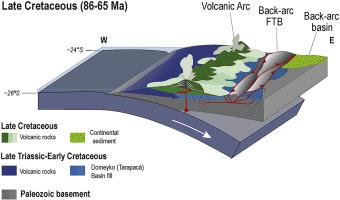当前位置:
X-MOL 学术
›
J. South Am. Earth Sci.
›
论文详情
Our official English website, www.x-mol.net, welcomes your feedback! (Note: you will need to create a separate account there.)
Evidence for two stages of back-arc compression in the late Cretaceous fold-and-thrust belt in the Precordillera of northern Chile (24º30′S–25º30′S)
Journal of South American Earth Sciences ( IF 1.8 ) Pub Date : 2020-11-01 , DOI: 10.1016/j.jsames.2020.102706 Rodrigo González , Daniela Espinoza , Francisca Robledo , Vicente Jeria , Mauricio Espinoza , Paulina Torres , Héctor Rogers
Journal of South American Earth Sciences ( IF 1.8 ) Pub Date : 2020-11-01 , DOI: 10.1016/j.jsames.2020.102706 Rodrigo González , Daniela Espinoza , Francisca Robledo , Vicente Jeria , Mauricio Espinoza , Paulina Torres , Héctor Rogers

|
Abstract In the Andean forearc of northern Chile, the interplay between deformation and magmatism is not fully understood. Outcrops in the Precordillera of northern Chile record a long and complex history of magmatism and overprinting deformational events. The growth of the Precordillera is predominantly associated with the Late Eocene-Early Oligocene transpressive Domeyko fault system (Incaic Phase), however, a series of compressive late Cretaceous folds and faults have also been recognized. In this study, we combined structural mapping, stereographic fold analysis, and geochronologic data of both deformed rocks and post-tectonic hypabyssal bodies to reveal the distribution and kinematics of the late Cretaceous thrust system exposed in the Precordillera between 24°30′S and 25°30′S. We identified an approximately NS-striking belt of reverse faults and folds along the Precordillera, which was cut and displaced by the Late Eocene-Early Oligocene Domeyko fault system. This deformation corresponds to thick-skinned structures affecting Paleozoic basement and thin-skinned structures which include folding with a general sub-horizontal NNW-SSE shortening direction with westward and eastward vergence. The ages of post-tectonic hypabyssal bodies cutting the deformed rocks indicate that the timing of the contractional structures occurred before 86 Ma taking place in the westernmost margin of Precordillera and continued between 72 Ma and 65 Ma. Our results agree with the timing proposed for regional Peruvian and ‘K-T’ deformations. We also used the distribution of the syn-kinematic late Cretaceous volcanic rocks to identify late Cretaceous contraction that evolved into a back-arc fold-and-thrust belt. Its structures are currently distributed along the northern Precordillera and were obliterated by younger strike-slip Incaic deformation. Moreover, this deformation must have forced the topography upward, creating an early late Cretaceous topographic relief related to the tectonic activity along these structures. These results indicate that late Cretaceous deformation had a role in the early history of the proto-Precordillera of northern Chile, prior to development of the strike-slip Domeyko fault system in the Paleogene.
中文翻译:

智利北部Precordillera(24º30′S–25º30′S)晚白垩世褶皱冲断带两阶段弧后压缩的证据
摘要 在智利北部安第斯弧前弧,变形与岩浆作用之间的相互作用尚未完全清楚。智利北部 Precordillera 的露头记录了岩浆作用和叠印变形事件的漫长而复杂的历史。Precordillera 的生长主要与晚始新世-早渐新世横压 Domeyko 断层系统(Incaic 期)有关,但是,也发现了一系列晚白垩世压缩褶皱和断层。在这项研究中,我们结合变形岩石和后构造下层体的构造绘图、立体褶皱分析和年代学数据,揭示了 24°30'S 和 25°S 之间出露于 Precordillera 的晚白垩世逆冲系统的分布和运动学。 °30′S。我们确定了一条沿 Precordillera 的大约 NS 走向的反向断层和褶皱带,它被晚始新世-早渐新世 Domeyko 断层系统切割和置换。这种变形对应于影响古生界基底的厚皮构造和薄皮构造,包括具有一般亚水平 NNW-SSE 缩短方向的褶皱,向西和向东辐合。后构造下层体切割变形岩石的年龄表明,收缩结构的时间发生在 86 Ma 之前发生在 Precordillera 最西缘,并在 72 Ma 和 65 Ma 之间持续。我们的结果与为区域秘鲁和“K-T”变形提出的时间安排一致。我们还利用同运动学晚白垩世火山岩的分布来确定晚白垩世收缩演化为弧后褶皱冲断带。它的结构目前分布在北部 Precordillera 并被较年轻的走滑印加变形破坏。此外,这种变形一定迫使地形向上,形成了与沿这些结构的构造活动相关的早白垩世晚期地形起伏。这些结果表明晚白垩世变形在智利北部原始 Precordillera 的早期历史中起作用,在古近纪走滑 Domeyko 断层系统发育之前。它的结构目前分布在北部 Precordillera 并被较年轻的走滑印加变形破坏。此外,这种变形一定迫使地形向上,形成了与沿这些结构的构造活动相关的早白垩世晚期地形起伏。这些结果表明晚白垩世变形在智利北部原始 Precordillera 的早期历史中起作用,在古近纪走滑 Domeyko 断层系统发育之前。它的结构目前分布在北部 Precordillera 并被较年轻的走滑印加变形破坏。此外,这种变形一定迫使地形向上,形成了与沿这些结构的构造活动相关的早白垩世晚期地形起伏。这些结果表明晚白垩世变形在智利北部原始 Precordillera 的早期历史中起作用,在古近纪走滑 Domeyko 断层系统发育之前。
更新日期:2020-11-01
中文翻译:

智利北部Precordillera(24º30′S–25º30′S)晚白垩世褶皱冲断带两阶段弧后压缩的证据
摘要 在智利北部安第斯弧前弧,变形与岩浆作用之间的相互作用尚未完全清楚。智利北部 Precordillera 的露头记录了岩浆作用和叠印变形事件的漫长而复杂的历史。Precordillera 的生长主要与晚始新世-早渐新世横压 Domeyko 断层系统(Incaic 期)有关,但是,也发现了一系列晚白垩世压缩褶皱和断层。在这项研究中,我们结合变形岩石和后构造下层体的构造绘图、立体褶皱分析和年代学数据,揭示了 24°30'S 和 25°S 之间出露于 Precordillera 的晚白垩世逆冲系统的分布和运动学。 °30′S。我们确定了一条沿 Precordillera 的大约 NS 走向的反向断层和褶皱带,它被晚始新世-早渐新世 Domeyko 断层系统切割和置换。这种变形对应于影响古生界基底的厚皮构造和薄皮构造,包括具有一般亚水平 NNW-SSE 缩短方向的褶皱,向西和向东辐合。后构造下层体切割变形岩石的年龄表明,收缩结构的时间发生在 86 Ma 之前发生在 Precordillera 最西缘,并在 72 Ma 和 65 Ma 之间持续。我们的结果与为区域秘鲁和“K-T”变形提出的时间安排一致。我们还利用同运动学晚白垩世火山岩的分布来确定晚白垩世收缩演化为弧后褶皱冲断带。它的结构目前分布在北部 Precordillera 并被较年轻的走滑印加变形破坏。此外,这种变形一定迫使地形向上,形成了与沿这些结构的构造活动相关的早白垩世晚期地形起伏。这些结果表明晚白垩世变形在智利北部原始 Precordillera 的早期历史中起作用,在古近纪走滑 Domeyko 断层系统发育之前。它的结构目前分布在北部 Precordillera 并被较年轻的走滑印加变形破坏。此外,这种变形一定迫使地形向上,形成了与沿这些结构的构造活动相关的早白垩世晚期地形起伏。这些结果表明晚白垩世变形在智利北部原始 Precordillera 的早期历史中起作用,在古近纪走滑 Domeyko 断层系统发育之前。它的结构目前分布在北部 Precordillera 并被较年轻的走滑印加变形破坏。此外,这种变形一定迫使地形向上,形成了与沿这些结构的构造活动相关的早白垩世晚期地形起伏。这些结果表明晚白垩世变形在智利北部原始 Precordillera 的早期历史中起作用,在古近纪走滑 Domeyko 断层系统发育之前。



























 京公网安备 11010802027423号
京公网安备 11010802027423号